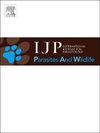Exposure of Eurasian blackbird (Turdus merula) to Toxoplasma gondii in an urban area in Thuringia, Germany
IF 2
3区 医学
Q3 ECOLOGY
International Journal for Parasitology-Parasites and Wildlife
Pub Date : 2025-03-24
DOI:10.1016/j.ijppaw.2025.101060
引用次数: 0
Abstract
Toxoplasma gondii is a zoonotic, globally distributed, obligate intracellular protozoan. Within the context of the ‘One Health’ approach, studies on toxoplasmosis are essential as it affects humans as well as domestic and wild animals, including birds. The Eurasian blackbird (Turdus merula) is one of the most common songbird species in Germany and previous studies have shown that they can be infected with T. gondii. The aim of the present study was to analyze T. gondii exposure in an urban blackbird population in Germany. Between 2018 and 2022, we collected fresh blackbird carcasses from an urban population in Heilbad Heiligenstadt, a small town in the German state of Thuringia. Altogether 112 blackbirds were analyzed for the presence of antibodies using a commercial indirect modified agglutination test (MAT) and parasite DNA (qPCR; brain and heart). The present study reports a high T. gondii seroprevalence as antibodies were detected in 50.9 % (57/112; 95 % CI: 41.6–60.2 %) of the urban blackbirds. However, T. gondii DNA was not detected in any of the samples analyzed. Body weight was identified as a risk factor, with heavier birds, both juveniles and adults, being more likely to test positive. Additionally, there was a significant interaction between body weight and sex. Our results suggest that T. gondii infection is widespread in the urban blackbird population, indicating a high parasite circulation in the environment.

德国图林根州城市地区欧亚黑鸟(Turdus merula)暴露于刚地弓形虫
刚地弓形虫是一种人畜共患的、全球分布的专性细胞内原生动物。在“同一个健康”方针的背景下,对弓形虫病的研究至关重要,因为它影响人类以及家畜和野生动物,包括鸟类。欧亚黑鸟(Turdus merula)是德国最常见的鸣禽之一,以前的研究表明它们可以感染弓形虫。本研究的目的是分析弓形虫暴露在德国城市黑鸟种群。在2018年至2022年期间,我们从德国图林根州的一个小镇Heilbad Heiligenstadt的城市人口中收集了新鲜的黑鸟尸体。采用商业间接修饰凝集试验(MAT)和寄生虫DNA (qPCR)对112只黑鹂进行抗体检测;大脑和心脏)。本研究报告弓形虫血清阳性率较高,抗体阳性率为50.9% (57/112;95% CI: 41.6 - 60.2%)。然而,在分析的任何样本中均未检测到弓形虫DNA。体重被认为是一个危险因素,无论是幼鸟还是成年鸟,体重较重的鸟更有可能检测出阳性。此外,体重和性别之间存在显著的相互作用。结果表明,弓形虫感染在城市黑鸟种群中广泛存在,表明弓形虫在环境中的高循环。
本文章由计算机程序翻译,如有差异,请以英文原文为准。
求助全文
约1分钟内获得全文
求助全文
来源期刊

International Journal for Parasitology-Parasites and Wildlife
Medicine-Infectious Diseases
CiteScore
3.80
自引率
5.60%
发文量
113
审稿时长
45 days
期刊介绍:
The International Journal for Parasitology: Parasites and Wildlife (IJP-PAW) publishes the results of original research on parasites of all wildlife, invertebrate and vertebrate. This includes free-ranging, wild populations, as well as captive wildlife, semi-domesticated species (e.g. reindeer) and farmed populations of recently domesticated or wild-captured species (e.g. cultured fishes). Articles on all aspects of wildlife parasitology are welcomed including taxonomy, biodiversity and distribution, ecology and epidemiology, population biology and host-parasite relationships. The impact of parasites on the health and conservation of wildlife is seen as an important area covered by the journal especially the potential role of environmental factors, for example climate. Also important to the journal is ''one health'' and the nature of interactions between wildlife, people and domestic animals, including disease emergence and zoonoses.
 求助内容:
求助内容: 应助结果提醒方式:
应助结果提醒方式:


